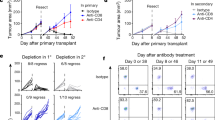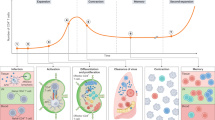Abstract
CD8+ cytotoxic T lymphocytes (CTLs) mediate resistance to infectious agents and tumours. Classically, CTLs recognize antigens that are localized in the cytoplasm of target cells, processed and presented as peptide complexes with class I molecules of the major histocompatibility complex (MHC)1. However, there is evidence for an exogenous pathway whereby antigens that are not expected to gain access to the cytoplasm are presented on MHC class I molecules2,3,4,5,6. The most dramatic example is the in vivo phenomenon of cross-priming7: antigens from donor cells are acquired by bone-marrow-derived host antigen-presenting cells (APCs) and presented on MHC class I molecules. Two unanswered questions concern the identity of this bone-marrow-derived cell and how such antigens are acquired. Here we show that human dendritic cells, but not macrophages, efficiently present antigen derived from apoptotic cells, stimulating class I-restricted CD8+ CTLs. Our findings suggest a mechanism by which potent APCs acquire antigens from tumours, transplants, infected cells, or even self-tissue, for stimulation or tolerization of CTLs.
This is a preview of subscription content, access via your institution
Access options
Subscribe to this journal
Receive 51 print issues and online access
$199.00 per year
only $3.90 per issue
Buy this article
- Purchase on Springer Link
- Instant access to full article PDF
Prices may be subject to local taxes which are calculated during checkout





Similar content being viewed by others
References
Heemels, M. T. & Ploegh, H. Generation, translocation, and presentation of MHC class I-restricted peptides. Ann. Rev. Biochem. 64, 463–491 (1995).
Watts, C. Capture and processing of exogenous antigens for presentation on MHC molecules. Annu. Rev. Immunol. 15, 821–850 (1997).
Kovacsovics-Bankowski, M. & Rock, K. L. Aphagosome-to-cytosol pathway for exogenous antigens presented on MHC class I molecules. Science 267, 243–246 (1995).
Suto, R. & Srivastava, P. K. Amechanism for the specific immunogenicity of heat shock-chaperoned peptides. Science 269, 1585–1588 (1995).
Norbury, C. C., Chambers, B. J., Prescott, A. R., Ljunggren, H.-G. & Watts, C. Constitutive macropinocytosis allows TAP-dependent presentation of exogenous antigen on class I MHC molecules by bone marrow derived dendritic cells. Eur. J. Immunol. 27, 280–288 (1997).
Pfeifer, J. D. et al. Phagocytic processing of bacterial antigens for class I MHC presentation to T cells. Nature 361, 359–363 (1993).
Bevan, M. J. Cross-priming for a secondary cytotoxic response to minor H antigens with H-2 congenic cells which do not cross-react in the cytotoxic assay. J. Exp. Med. 143, 1283–1288 (1976).
Bhardwaj, N. et al. Influenza virus-infected dendritic cells stimulate strong proliferative and cytolytic responses from human CD8+ T cells. J. Clin. Invest. 94, 797–807 (1994).
Bender, A. et al. The distinctive features of influenza virus infection of dendritic cells. Immunobiology (in the press).
Bender, A., Bui, L. K., Feldman, M. A. V., Larsson, M. & Bhardwaj, N. Inactivated influenza virus, when presented on dendritic cells, elicits human CD8+ cytolytic T cell responses. J. Exp. Med. 182, 1663–1671 (1995).
Fesq, H., Bacher, M., Nain, M. & Gemsa, D. Programmed cell death (apoptosis) in human monocytes infected by influenza virus. Immunobiology 190, 175–182 (1994).
Hofmann, P. et al. Susceptibility of mononuclear phagocytes to influenza A virus infection and possible role in the antiviral response. J. Leuk. Biol. 612, 408–414 (1997).
Bender, A., Sapp, M., Schuler, G., Steinman, R. M. & Bhardwaj, N. Improved methods for the generation of dendritic cells from nonproliferating progenitors in human blood. J. Immunol. Methods 196, 121–135 (1996).
Romani, N. et al. Generation of mature dendritic cells from human blood: an improved method with special regard to clinical applicability. J. Immunol. Methods 196, 137–151 (1996).
Badley, A. D. et al. Macrophage-dependent apoptosis of CD4+ T lymphocytes from HIV-infected individuals is mediated by FasL and tumor necrosis factor. J. Exp. Med. 185, 55–64 (1997).
Fenteany, G. et al. Inhibition of proteasome activities and subunit-specific amino-terminal threonine modification by lactacystin. Science 268, 726–731 (1995).
Rubartelli, A., Poggi, A. & Zocchi, M. R. The selective engulfment of apoptotic bodies by dendritic cells is mediated by the αvβ3 integrin and requires intracellular and extracellular calcium. Eur. J. Immunol. 27, 1893–1900 (1997).
Shen, Z., Reznikoff, G., Droanoff, G. & Rock, K. L. Cloned dendritic cells can present exogenous antigens on both MHC class I and class II molecules. J. Immunol. 158, 2723–2730 (1997).
Paglia, P., Chiodoni, C., Rodolfo, M. & Colombo, M. P. Murine dendritic cells loaded in vitro with soluble protein prime CTL against tumor antigen in vivo. J. Exp. Med. 183, 317–322 (1996).
Bachmann, M. F. et al. Dendritic cells process exogenous viral proteins and virus-like particles for class I presentation to CD8+ cytotoxic T lymphocytes. Eur. J. Immunol. 26, 1–7 (1996).
Fossum, S. & Rolstad, B. The roles of interdigitating cells and natural killer cells in the rapid rejection of allogeneic lymphocytes. Eur. J. Immunol. 16, 440–450 (1986).
Huang, A. Y. C. et al. Role of bone marrow-derived cells in presenting MHC class I-restricted tumor antigens. Science 264, 961–965 (1994).
Bevan, M. J. Priming for a cytotoxic response to minor histocompatibility antigens: antigen specificity and failure to demonstrate a carrier effect. J. Immunol. 118, 1370–1374 (1977).
Kurts, C. et al. Constitutive class I-restricted exogenous presentation of self antigens in vivo. J. Exp. Med. 184, 923–930 (1996).
Kurts, C., Kosaka, H., Carbone, F. R., Miller, J. F. A. P. & Heath, W. R. Class I-restricted cross-presentation of exogenous self antigens leads to deletion of autoreactive CD8+ T cells. J. Exp. Med. 186, 239–245 (1997).
Gotch, F., McMichael, A. & Rothbard, J. Recognition of influenza A matrix protein by HLA-A2-restricted cytotoxic T lymphocytes. J. Exp. Med. 168, 2045–2057 (1988).
Gotch, F., Rothbard, J., Howland, K., Townsend, A. & McMichael, A. Cytotoxic T lymphocytes recognize a fragment of influenza virus matrix protein in association with HLA-A2. Nature 326, 881 (1987).
Casciola-Rosen, L., Anhalt, G. & Rosen, A. Autoantigens targeted in systemic lupus erythematosus are clustered in two populations of surface structures on apoptotic keratinocytes. J. Exp. Med. 179, 1317–1330 (1994).
De Panfilis, G., Manara, G. C. & Ferrari, C. Hairy cell leukemia cells express CD1a antigen. J. Invest. Dermatol. 87, 510–514 (1986).
Acknowledgements
We thank R. Steinman, R. Darnell, Y. Choi and T. Sakmar for advice and critical review of the manuscript; G. Kaplan and W. Hellman for assistance with the EM; and B. van Steensel for assistance with the IF.
Author information
Authors and Affiliations
Rights and permissions
About this article
Cite this article
Albert, M., Sauter, B. & Bhardwaj, N. Dendritic cells acquire antigen from apoptotic cells and induce class I-restricted CTLs. Nature 392, 86–89 (1998). https://doi.org/10.1038/32183
Received:
Accepted:
Issue Date:
DOI: https://doi.org/10.1038/32183
This article is cited by
-
Dendritic cell subsets in cancer immunity and tumor antigen sensing
Cellular & Molecular Immunology (2023)
-
Vakzinierungsstrategien beim Mammakarzinom
Die Gynäkologie (2023)
-
Targeting SLC7A11 improves efferocytosis by dendritic cells and wound healing in diabetes
Nature (2022)
-
Recent advances in organic and polymeric carriers for local tumor chemo-immunotherapy
Science China Technological Sciences (2022)
-
DNA-launched RNA replicon vaccines induce potent anti-SARS-CoV-2 immune responses in mice
Scientific Reports (2021)
Comments
By submitting a comment you agree to abide by our Terms and Community Guidelines. If you find something abusive or that does not comply with our terms or guidelines please flag it as inappropriate.



